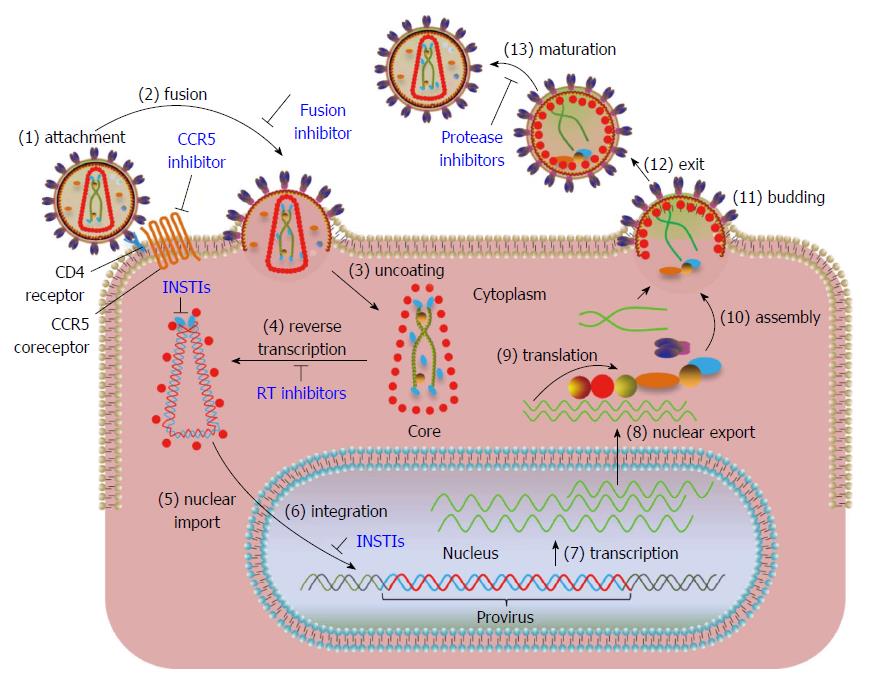Copyright
©The Author(s) 2015.
World J Biol Chem. Aug 26, 2015; 6(3): 83-94
Published online Aug 26, 2015. doi: 10.4331/wjbc.v6.i3.83
Published online Aug 26, 2015. doi: 10.4331/wjbc.v6.i3.83
Figure 1 Overview of human immunodeficiency virus type 1 replication cycle.
Steps in the viral replication cycle are numbered. The steps where FDA approved drugs exist are marked in blue. (1) The trimeric envelope glycoprotein (gp120/gp41) of human immunodeficiency virus (HIV) binds to the CD4 receptor and CCR5 co-receptors present on host cell surface. Maraviroc, a CCR5 receptor antagonist blocks the binding of viral gp120 to CCR5 and prevents the entry of virus into cells; (2) Viral membrane fuses with cellular membrane allowing the entry of the virus into the cytoplasm. Enfuvirtide, a fusion inhibitor binds to gp41 and prevents the formation of an entry pore for the capsid of the virus, thus blocking the entry of virus into the cytoplasm; (3) The virus undergoes uncoating of the core; (4) HIV RNA is reverse-transcribed by reverse transcriptase into double stranded DNA within the core. Reverse-transcriptase inhibitors block the synthesis of viral DNA; (5) Integrase (IN) cleaves two nucleotides adjacent to conserved CA nucleotides from both 3’-ends of viral DNA (referred as 3’-processing in text) and forms the preintegration complex (PIC). The PIC is transported into the nucleus through a cellular nuclear import pathway. IN strand transfer inhibitors (INSTIs) bind to the IN-DNA complex after 3’-processing rendering the cytoplasmic PIC defective for integration but not nuclear transport; (6) IN facilitates the joining of viral DNA to the host DNA (termed strand transfer in text). Integrated viral DNA is referred to as “provirus”. A cellular protein, lens-epithelium derived growth factor (LEDGF/p75), preferentially targets the integration of viral DNA within transcriptionally active regions. INSTIs block the joining of processed viral DNA ends into cellular DNA; (7) The viral DNA is transcribed by cellular RNA pol II into viral RNAs; (8) Full-length and alternatively spliced RNAs are transported out of nucleus; (9) Viral proteins are synthesized from the RNA template; (10) Full-length viral RNA and newly synthesized proteins begin the assembly of new virus particles at the inner surface of cell membrane; (11) Immature viral particles bud out of the membrane and released (12); and (13) Proteolytic processing of viral proteins results in the maturation of viral particle. Protease inhibitors block the formation of mature proteins by inhibiting the proteolytic processing of the viral polyproteins.
- Citation: Grandgenett DP, Pandey KK, Bera S, Aihara H. Multifunctional facets of retrovirus integrase. World J Biol Chem 2015; 6(3): 83-94
- URL: https://www.wjgnet.com/1949-8454/full/v6/i3/83.htm
- DOI: https://dx.doi.org/10.4331/wjbc.v6.i3.83









